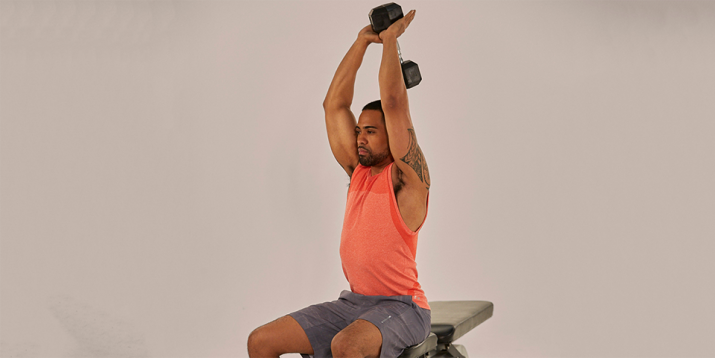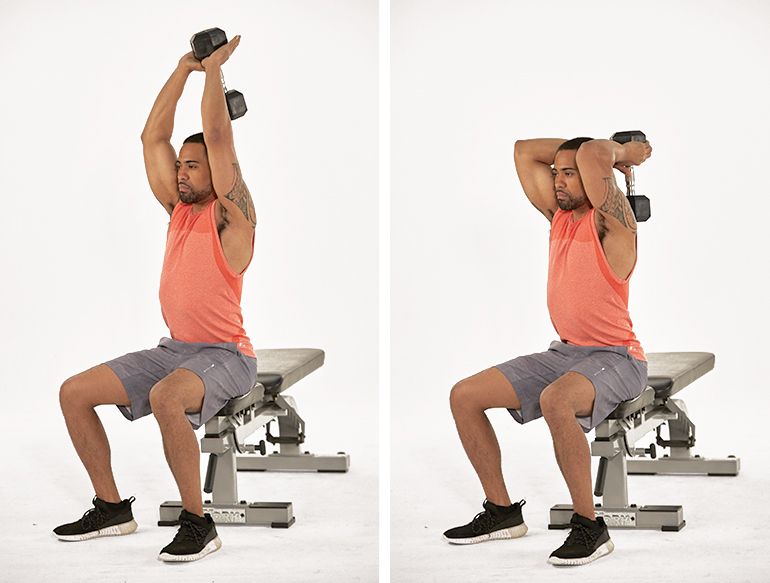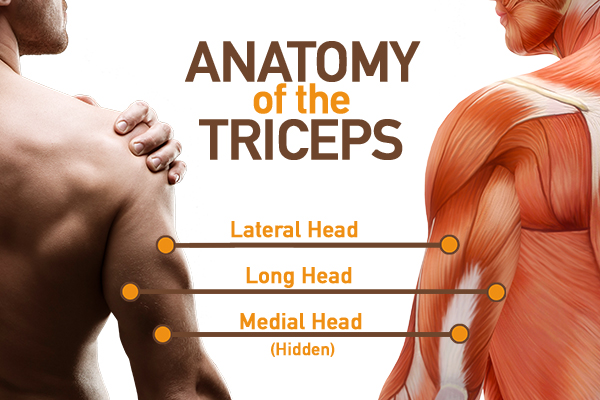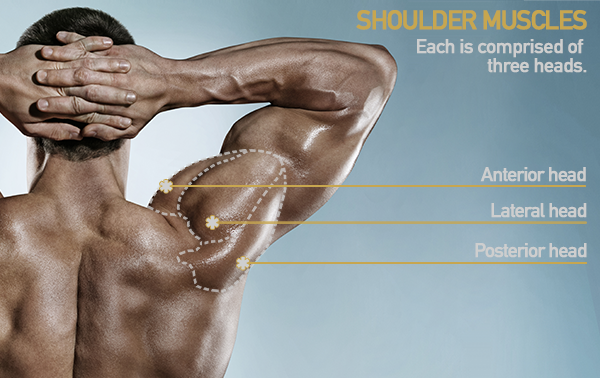How to Do an Overhead Triceps Extension (Video)

Though they might seem like just a vanity muscle, triceps are critical to your upper body’s overall strength and power. And since the triceps muscle accounts for two-thirds of your upper arm’s overall mass, isolating it is key to gaining size and strength.
One of the best movements for accomplishing this is the overhead triceps extension.
The overhead triceps extension should be a key player in every triceps workout. It won’t just help you build strong tris; the move also helps set you up for success in other areas.
As Cody Braun, CSCS, notes, strong triceps “assist the chest and shoulder muscles in many functional pressing movements.”
Think: common weightlifting exercises like the shoulder press and bench press, plus everyday movements like picking up your kids or putting away heavy groceries on high shelves.
Dumbbell Overhead Triceps Extension: Step-by-Step Instructions
Appears in: P90X – Chest, Shoulders & Triceps
- Stand with your feet staggered while holding a pair of dumbbells directly overhead in your hands, with your palms facing each other and the weights touching.
- Without moving your upper arms, lower the weights behind your head. Keep the dumbbells pressed together the whole time.
- Press the weights back up to the starting position until your arms are fully extended, stopping short of locking them out.
- Alternate your forward foot each set.
How to Make the Overhead Triceps Extension Easier (and Harder)
To modify the move, use lighter weights or use a single dumbbell instead of two. If you have limited shoulder mobility or core strength, Braun suggests sitting on an upright bench for this exercise.
To intensify the overhead triceps extension, use heavier weights, or try balancing on one foot to further challenge your core.
Bonus Tips for Doing the Overhead Triceps Extension

Braun suggests warming up your shoulders first for better mobility. Also, remember to engage your core — this will help protect your lower back and prevent it from arching or swaying.
Finally, it’s an isolation exercise, so you don’t want to go too heavy, or else you may sacrifice form and the full range of motion necessary to take full advantage of the move.
Variations on the Overhead Triceps Extension
If you have access to a weight machine, try the cable overhead triceps extension. This, too, can be performed standing or seated.
Benefits of the Overhead Triceps Extension
The overhead triceps extension achieves a few important objectives. Beyond strengthening all three heads of the triceps (more on that below), it also activates your core and recruits your shoulder muscles for stability, Braun says.
Plus, in the variation depicted in the video above, the overhead triceps extension targets each arm separately, forcing you to confront and correct any muscle imbalances you might have.
What Muscles Are Used in the Overhead Triceps Extension?
Triceps

It’s no surprise which muscle benefits most from the overhead triceps extension.
But the way in which the muscle is worked during any triceps exercise varies depending on a number of factors, including grip, body position, and plane of movement.
The triceps is a single muscle comprised of three heads. Working outward from body, they are: the long head, the medial head, and the lateral head.
The medial and lateral heads originate atop the humerus (upper-arm bone), while the long head originates at the scapula (shoulder blade).
They all eventually fuse together and attach at the elbow to facilitate the straightening of your arm.
The medial head is framed by the other two, which form the horseshoe associated with a defined triceps muscle.
Deltoid

This is the muscle most responsible for movement of your shoulder, the body’s most mobile joint.
It’s comprised of three sections: the anterior (front) deltoid, which helps raise your arm forward; the lateral (side) deltoid, which helps raise your arm out to the side; and the posterior (rear) deltoid, which helps raise your arm behind you.
In an overhead triceps extension, the anterior delt receives the greatest emphasis.
Alternatives to the Dumbbell Overhead Triceps Extension
Here are some other exercises that target the triceps just as effectively.
1. Skull crusher
Appears in: Body Beast >> Chest/Tris
- Lie down on a bench or the floor holding a pair of dumbbells directly above your chest with your palms facing each other. Your feet should be flat on the floor.
- Without moving your upper arms, bend your elbows and slowly lower the weights toward the sides of your head. Avoid flaring your elbows.
- Reverse the move to return to the starting position. Repeat for reps.
2. Triceps kickback
Appears in: P90X >> Shoulders and Arms
- Stand holding a pair of dumbbells in front of your shoulders (palms facing inward) with your elbows bent and at your sides.
- Step one foot back, and bend your knees slightly. Hinge forward at your hips so that your chest is almost parallel to the floor. This is the starting position.
- Keeping your back flat, core engaged, and upper arms firmly at your sides, straighten your elbows, pushing the weights back as you fully extend your forearms behind you.
- Bring the dumbbells back to the starting position, and repeat. Alternate your forward leg with each set.
3. Triceps rope pushdown
Appears in: Sagi’s BOD exclusives – Chest and Tris
- Hook a two-handled rope attachment up to a cable machine, and set the pulley around shoulder height.
- Grasp the handles with your palms facing inward, and step backward a foot or two in order to create tension on the cable. Then hinge forward with your torso about 30 degrees.
- Keeping your elbows at your sides, extend your arms fully toward the floor.
- Reverse the movement to return to the starting position, and repeat.
